1. Cullen KA, Hall MJ, Golosinskiy A. Ambulatory surgery in the United States, 2006. Natl Health Stat Rep. 2009; (11):1–25.
2. Choi HG, Hah JH, Jung YH, Kim DW, Sung MW. Influences of demographic changes and medical insurance status on tonsillectomy and adenoidectomy rates in Korea. Eur Arch Otorhinolaryngol. 2014; 271(8):2293–2298. PMID:
24136477.

3. Kim JW, Kim HJ, Lee WH, Kim DK, Kim SW, Kim YH, et al. Comparative study for efficacy and safety of adenoidectomy according to the surgical method: a prospective multicenter study. PLoS One. 2015; 10(8):e0135304. PMID:
26267337.

4. Maheswaran S, Rupa V, Ebenezer J, Manoharan A, Irodi A. Relative etiological importance of adenoid hypertrophy versus sinusitis in children with persistent rhinorrhoea. Indian J Otolaryngol Head Neck Surg. 2015; 67(1):34–38.

5. Lin CD, Tsai MH, Lin CW, Ho MW, Wang CY, Tsou YA, et al. Association of adenoid hyperplasia and bacterial biofilm formation in children with adenoiditis in Taiwan. Eur Arch Otorhinolaryngol. 2012; 269(2):503–511. PMID:
21779840.

6. Lee D, Rosenfeld RM. Adenoid bacteriology and sinonasal symptoms in children. Otolaryngol Head Neck Surg. 1997; 116(3):301–307. PMID:
9121781.
7. Evcimik MF, Dogru M, Cirik AA, Nepesov MI. Adenoid hypertrophy in children with allergic disease and influential factors. Int J Pediatr Otorhinolaryngol. 2015; 79(5):694–697. PMID:
25758194.

8. Shin KS, Cho SH, Kim KR, Tae K, Lee SH, Park CW, et al. The role of adenoids in pediatric rhinosinusitis. Int J Pediatr Otorhinolaryngol. 2008; 72(11):1643–1650. PMID:
18789545.

9. Berçin AS, Ural A, Kutluhan A, Yurttaş V. Relationship between sinusitis and adenoid size in pediatric age group. Ann Otol Rhinol Laryngol. 2007; 116(7):550–553. PMID:
17727087.

10. van den Aardweg MT, Schilder AG, Herkert E, Boonacker CW, Rovers MM. Adenoidectomy for recurrent or chronic nasal symptoms in children. Cochrane Database Syst Rev. 2010; (1):CD008282. PMID:
20091663.

11. Brietzke SE, Gallagher D. The effectiveness of tonsillectomy and adenoidectomy in the treatment of pediatric obstructive sleep apnea/hypopnea syndrome: a meta-analysis. Otolaryngol Head Neck Surg. 2006; 134(6):979–984. PMID:
16730542.

12. Paradise JL, Bluestone CD, Rogers KD, Taylor FH, Colborn DK, Bachman RZ, et al. Efficacy of adenoidectomy for recurrent otitis media in children previously treated with tympanostomy-tube placement. Results of parallel randomized and nonrandomized trials. JAMA. 1990; 263(15):2066–2073. PMID:
2181158.

13. Ungkanont K, Damrongsak S. Effect of adenoidectomy in children with complex problems of rhinosinusitis and associated diseases. Int J Pediatr Otorhinolaryngol. 2004; 68(4):447–451. PMID:
15013612.

14. Elwany S, El-Dine AN, El-Medany A, Omran A, Mandour Z, El-Salam AA. Relationship between bacteriology of the adenoid core and middle meatus in children with sinusitis. J Laryngol Otol. 2011; 125(3):279–281. PMID:
21144114.

15. van den Aardweg MT, Boonacker CW, Rovers MM, Hoes AW, Schilder AG. Effectiveness of adenoidectomy in children with recurrent upper respiratory tract infections: open randomised controlled trial. BMJ. 2011; 343:d5154. PMID:
21896611.

16. Koivunen P, Uhari M, Luotonen J, Kristo A, Raski R, Pokka T, et al. Adenoidectomy versus chemoprophylaxis and placebo for recurrent acute otitis media in children aged under 2 years: randomised controlled trial. BMJ. 2004; 328(7438):487. PMID:
14769785.

17. Rynnel-Dagöö B, Ahlbom A, Schiratzki H. Effects of adenoidectomy: a controlled two-year follow-up. Ann Otol Rhinol Laryngol. 1978; 87(2 Pt 1):272–278. PMID:
646300.
18. Korean National Health Insurance Sharing Service cohort study DB. Updated 2014. Accessed March 26, 2016.
http://nhiss.nhis.or.kr/.
19. Arnaoutakis D, Collins WO. Correlation of mucociliary clearance and symptomatology before and after adenoidectomy in children. Int J Pediatr Otorhinolaryngol. 2011; 75(10):1318–1321. PMID:
21851991.

20. Tuncer U, Aydogan B, Soylu L, Simsek M, Akcali C, Kucukcan A. Chronic rhinosinusitis and adenoid hypertrophy in children. Am J Otolaryngol. 2004; 25(1):5–10. PMID:
15011200.

21. Takahashi H, Honjo I, Fujita A, Kurata K. Effects of adenoidectomy on sinusitis. Acta Otorhinolaryngol Belg. 1997; 51(2):85–87. PMID:
9241373.
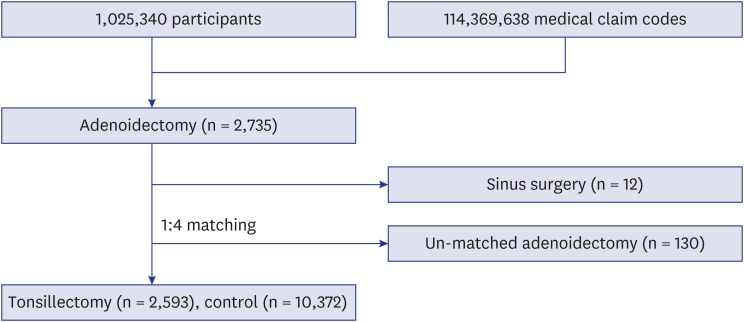
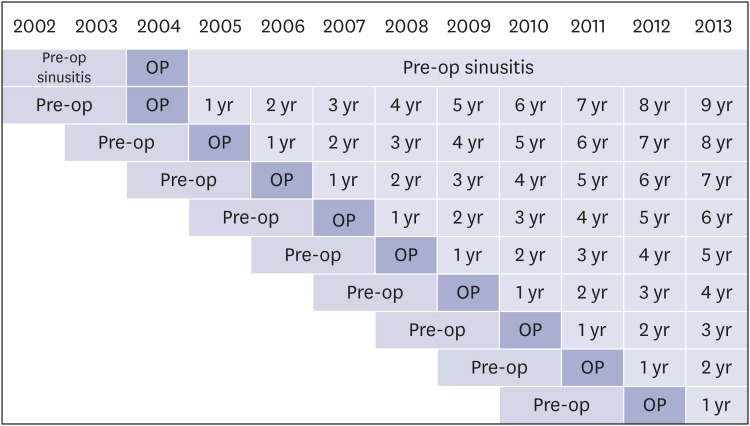
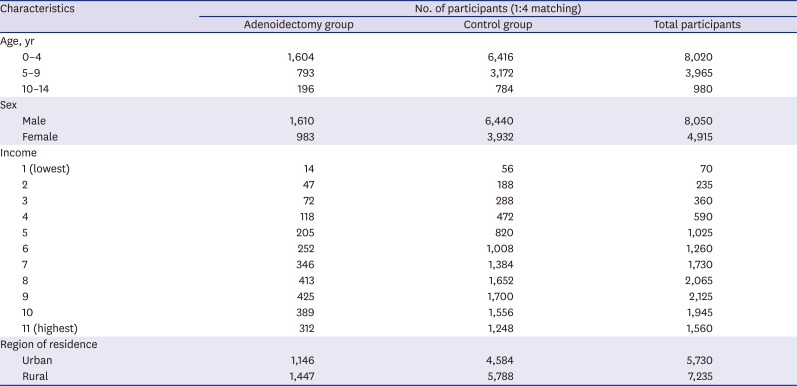

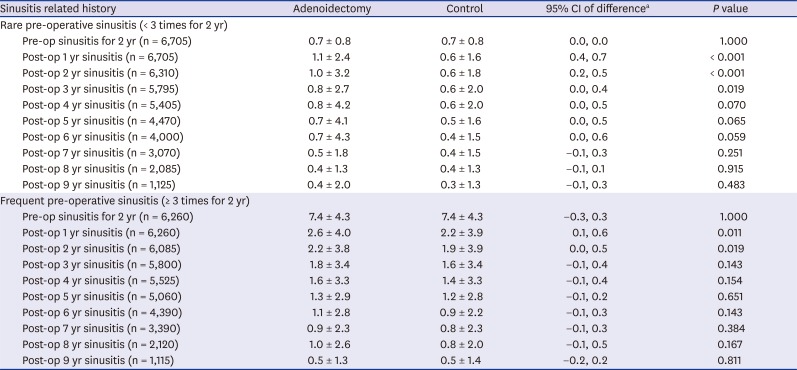
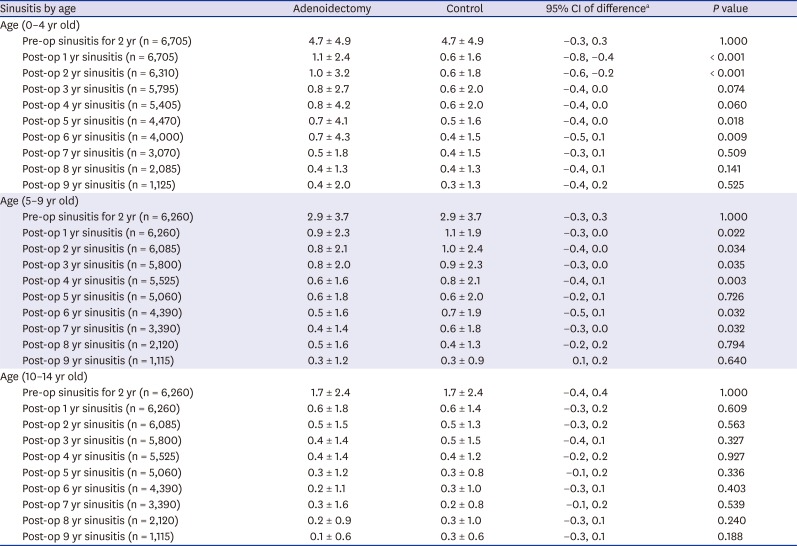




 PDF
PDF Citation
Citation Print
Print



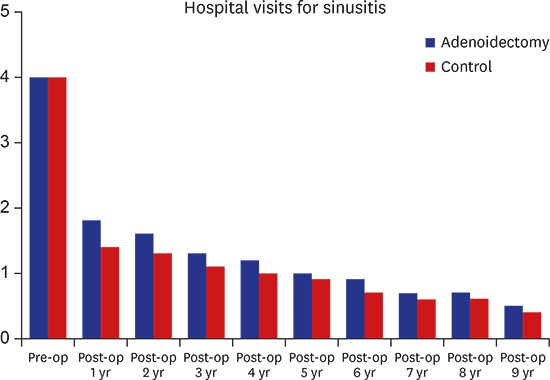
 XML Download
XML Download